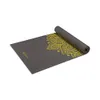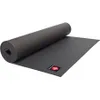
Say hey to stronger glutes and more mobile hips while bulletproofing your lower body using this one bodyweight exercise. It takes no more than a minute per leg and has the potential to vastly improve your range of motion, meaning deeper squats and better performance while you lift weights, run, or anything in between.
If your goal for the new year is to live life below parallel, adding this strength and mobility move to your routine could be a game-changer for your hip health. And I, personally, can’t get enough of it.
You can use a chirp wheel, yoga block, or even one of the best foam rollers for recovery to perform the exercise. Check out my video below for how to execute it step-by-step, plus the benefits and tips for scaling to your ability.
What is the mobility exercise for stronger hips and glutes?
Here are three words that will change your approach to strengthening your hips and glutes from now on: hip internal rotation.
There’s a key difference between building long-term improvements to your range of motion and temporarily relieving tight muscles to increase flexibility, and that's stretching versus mobility.
Mobility routines combine strength and movement around joints and within muscles to improve your mechanics over time, and that’s why I always recommend them if you get stiff or find your movement limited.
Rather than just holding a stretch at your end range, which may offer temporary relief, you’ll create movement around it, strengthening and "oiling" the joints, ligaments and muscles using range of motion (ROM).
Sign up to get the BEST of Tom's Guide direct to your inbox.
Get instant access to breaking news, the hottest reviews, great deals and helpful tips.
To help build strength in your hips and glutes, hip internal rotation should be part of your mobility program. Here’s why.
What is internal rotation of the hip?

This form of rotation means moving your hip inward, or your thigh toward your midline, primarily targeting muscles such as the gluteus minimus and medius, the adductors and the tensor fascia latae.
This motion improves your ability to use your internal rotators, and combined with external rotation exercises, can improve the overall quality of your movement mechanics, allowing your legs the freedom they need to move while you walk, run, or jump.
Working on your internal rotation mobility over time can help you target the muscles surrounding your pelvis, building strength in these smaller, stabilizing muscles, including the various hip and gluteal-located muscles.
What exercises use internal rotation?
The best hip internal rotation exercises can reduce hip pain associated with poor movement mechanics. So, I've plucked a few to get you going.
You can learn to unstick your hips with this mobility exercise from a chiropractor or give the 90/90 stretch (above) a try to get you started. To add movement to the 90-90, raise your back foot away from the mat and lower it again for 8-10 reps, then switch sides.
Some people even find their mobility improves following side plank practice.
But my favorite is the prone internal rotator drill. This simple move could do wonders for your internal rotation skills. Lay on your stomach, bend one leg out to the side and elevate it. Creating a deficit allows you to practice lifting and lowering your foot while keeping your hips square to the mat. Immediately, you'll feel this working the hip and glute and stretching the inner leg.
I recommend anywhere between 2-4 sets of 8-12 reps per leg, depending on how much time you have. To gain the benefits, as little as 60 seconds per side repeated consistently should do the trick.
If you experience any pain, pinching, or numbness, or you're unsure whether or not you are cleared for exercise, stop immediately and speak with your physician before starting a new workout regime.
What are the symptoms of poor internal hip rotation?
If you find it difficult to lift your legs or you overpronate the feet, this could indicate that your internal hip rotation needs work.
However, I strongly recommend seeking a referral from your physician to a qualified medical professional such as a physiotherapist, chiropractor, or similar, to seek a proper diagnosis.
According to Dr. Márcia Perretto, publishing on Actify PT physiotherapy, you need enough hip internal rotation to “sufficiently extend the hip.” Without it, you may experience gluteal muscle inhibition or inactive glutes.
Perretto explains that insufficient internal rotation limits how far your pelvis can move over your stance leg, meaning a shorter stride. “Lazy” glutes, as I refer to them, can strain the lower back, hips and hamstrings, causing overcompensation elsewhere over time, increasing your risk of injury.
While mobility exercises may not be as exciting as lifting heavy weights, blowing off steam on a run, or heading into your favorite Pilates studio, these sorts of moves are a type of strength training for your joints and muscles. And they’ll keep you doing the exercise you love for longer.
More from Tom's Guide
- 3 assisted stretches develop flexibility and strength without equipment
- You don't need weights to build full-body muscle, just 30 minutes and this equipment-free workout
- I’m a personal trainer — this is the 20-minute walking workout I use to build strength without weights and boost metabolism

Sam Hopes is a level 3 qualified trainer, level 2 reiki practitioner and senior fitness writer at Tom's Guide. She is also currently undertaking her Yoga For Athletes training course. Sam has written for various fitness brands and websites over the years and has experience across brands at Future such as Live Science, Fit&Well, Coach, and T3.
Having worked with fitness studios like F45 and Virgin Active, Sam now primarily teaches outdoor bootcamps, bodyweight, calisthenics and kettlebells. She also coaches mobility and stretching-focused classes several times a week and believes that true strength comes from a holistic approach to training your body.
Sam has completed two mixed doubles Hyrox competitions in London and the Netherlands and finished her first doubles attempt in 1:11.









